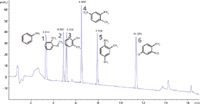Developing a UHPLC Method for UV-based Detection and Quantification of Primary Aromatic Amines in Low Concentrations
The Application Notebook
Agilent Application Note
This application demonstrates that stringent sensitivity requirements for the detection of potentially harmful primary aromatic amines can be fulfilled when using an Agilent 1290 Infinity LC system equipped with the 1290 large volume injection kit.
Primary aromatic amines (PAAs) can originate from printing azodyes and azo-pigments. PAAs are potentially harmful and suspected to cause cancer; they have to be detected and determined.
Regulation (EC) 10/2011 sets a limit of 10 ppb for the sum of the released PAAs from plastic food contactmaterials. In the field of paper and board for food contact a similar limit is mentioned within BfR recommendation XXXVI. Moreover, the upcoming German regulation for printing inks used for food contact materials (Druckfarben V) negates the already introduced limit of 10 ppb for the sum of the released PAAs to all materials. Recently, problems have been reported within industry and enforcement authorities regarding the release of carcinogenic PAAs from heavily printed paper bags and napkins.

Figure 1: Primary aromatic amines at 100 ng/mL: 1) Aniline: 3.314 min, 2) o-Anisidine: 4.882 min, 3) o-Toluidine: 5.159 min, 4) 2-Methyl-5-nitroanilin: 6.488 min, 5) 2,4-dimethylanilin: 7.908 min and 6) 2,4-dichloranilin: 11.373 min.
Since the legal limits apply to the sum of all PAAs, these compounds have to be detected down to a level of at least 1 ppb (1 ng/mL) for an individual PAA.
Experimental
To meet these requirements, two modifications were made to the standard configuration of the Agilent 1290 Infinity LC System. A 60-mm Max-Light high sensitivity flow cell was used with the 1290 Infinity Diode Array Detector. A 40-µL loop including the 1290 large volume injection kit to inject volumes up to 120 µL was used with the 1290 Infinity Autosampler.
The method that was finally applied was developed by using a mixture of six primary aromatic amines at 100 ng/mL: 1) aniline, 2) o-anisidine, 3) o-toluidine, 4) 2-methyl-5-nitroanilin, 5) 2, 4-dimethylanilin and 6) 2, 4-dichloranilin (Figure 1).
The method starts with an enrichment step for the first minute followed by a steep increase to the starting conditions at 20% methanol. The gradient separation was done in the following 13 min up to 70% methanol on an Agilent ZORBAX Eclipse Plus C18, RRHT, 3.0 × 100 mm, 1.8 µm column.
Results
With the final method, a calibration was done for all PAAs from 100 ng/mL down to a level of 2 ng/mL (2 ppb). All linearity correlation coefficients were above 0.99983. The concentration level at 2 ng/mL was defined as the limit of quantification (LOQ signaltonoise ratio around 10). The limit of detection (LOD) was 0.5 ng/mL (signaltonoise ratio around 3).
A statistical evaluation was done on the 10 ng/mL level. The relative standard deviation (RSD) of the retention times was between 0.039% and 0.057%, the area RSDs were between 0.5% and 2.7%. Relative standard deviation of the compound response factors were between 0.004 and 0.017%.
To test the method, a blank matrix sample produced from a heavily coloured napkin was spiked with the six PAAs at various concentrations. All six PAAs could be well separated from the matrix compounds and identified and quantified with the developed method and calibration.
Conclusion
This application shows that the Agilent 1290 Infinity LC system can detect low amounts of primary aromatic amines by using the 60mm Max-Light high sensitivity cell in the diode array detector, and the large volume injection kit in the autosampler.
Agilent Technologies Inc.
5301 Stevens Creek Blvd., Santa Clara, California 95051, USA
tel. (800) 227 9770 (Directory) fax (866) 497 1134
Website: www.agilent.com

Accelerating Monoclonal Antibody Quality Control: The Role of LC–MS in Upstream Bioprocessing
This study highlights the promising potential of LC–MS as a powerful tool for mAb quality control within the context of upstream processing.
Using GC-MS to Measure Improvement Efforts to TNT-Contaminated Soil
April 29th 2025Researchers developing a plant microbial consortium that can repair in-situ high concentration TNT (1434 mg/kg) contaminated soil, as well as overcome the limitations of previous studies that only focused on simulated pollution, used untargeted metabolone gas chromatography-mass spectrometry (GC-MS) to measure their success.
Prioritizing Non-Target Screening in LC–HRMS Environmental Sample Analysis
April 28th 2025When analyzing samples using liquid chromatography–high-resolution mass spectrometry, there are various ways the processes can be improved. Researchers created new methods for prioritizing these strategies.
Potential Obstacles in Chromatographic Analyses Distinguishing Marijuana from Hemp
April 28th 2025LCGC International's April series for National Cannabis Awareness Month concludes with a discussion with Walter B. Wilson from the National Institute of Standard and Technology’s (NIST’s) Chemical Sciences Division regarding recent research his team conducted investigating chromatographic interferences that can potentially inflate the levels of Δ9-THC in Cannabis sativa plant samples, and possible solutions to avoid this problem.

.png&w=3840&q=75)

.png&w=3840&q=75)



.png&w=3840&q=75)



.png&w=3840&q=75)




















